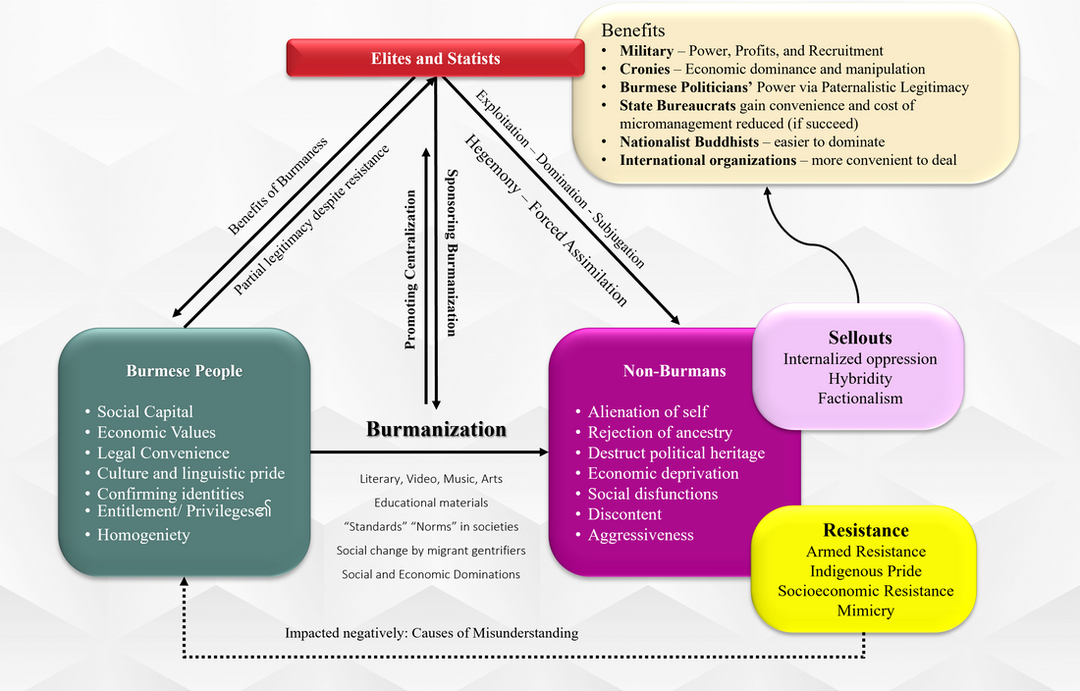Burmanization - Centralization Loop

During the colonial era, the term "Burmanization" was initially used by the British as a simple process. It aimed to make the administrative machinery more practical for locals by utilizing the Burmese people and customs. However, over time, this process evolved into a more complex and deliberate strategy. Today, Burmanization refers to a pressured process of imposing Burmese identity across the entire country, forcing indigenous nations to prioritize Burmese history, identity, and way of life. It has become a state-sponsored process of pressuring non-Burmese cultures, languages, political heritage, and symbols to exist under the dominance of Burmese heritage and culture.
The core of Burmanization cannot be separated from centralization. Centralization refers not only to political power but also to monopolizing the authority to use violence, monopoly of economic power, and monopoly of control over historical narratives. Through these methods, power becomes concentrated in the hands of the military and a few elites. The state that promotes Burmanization policies uses culture as a tool to strengthen their authority.
When Burmanized, non-Burmese indigenous peoples become Burmese, but may not be fully so. This increases social capital for the Burmese population. Speaking Burmese and having Burmese identity becomes economic capital and value. Burmese people understand the language of the law better and have more advantages. They dominate in culture and history. A Burmese person doesn't need to validate their existence. The history taught in school doesn't differ much from what they learn at home. Social networks, friends, understanding, and processes like taking matriculation exams in Burmese language or obtaining ID cards are accessible without much effort. These benefits exist to varying degrees.
The methods of Burmanization range from literature, video, music, art, and educational materials to establishing social "standards" and "routines." Additionally, migrant workers and economic influences support this process. In this way, the state suppresses indigenous ethnic identities and appropriates their traditional cultures. As a result, indigenous nations become disconnected from their history, economically disadvantaged, faced with land seizures and human trafficking, and socially fragmented.
Burmanization not only changes cultural expressions but also transforms the basic infrastructure of society. It weakens traditional governance systems and removes challenges to state sovereignty, making it easier to resolve legal issues related to land and resources. When the state seizes land, people are trafficked while seeking work in other countries. When working in other regions, the weak are trampled like in the law of the jungle. As indigenous peoples' rights weaken, the state gains easier access to natural resources like minerals, timber, and water. This leads to economic exploitation and resource extraction.
Let's list some points:
In reality, the main beneficiaries of Burmanization are not ordinary citizens but the economic elites and state elites. The military expands its power and profits, using this process to gain economic benefits. Those connected to the group receive uncompetitive economic opportunities, and Burmese politicians use paternalistic legitimacy to build power. International organizations also find it easier to work with a centralized state rather than multiple ethnic groups. It benefits the elites the most.
Burmanization is a strategy that uses cultural diversity as a weapon for political and economic control. It is a tool of centralization used by authoritarians to simplify administration, control resources, and rewrite narratives, while eliminating the identities of ethnic groups. While this system appears to benefit the Burmese public to some extent, elites gain benefits, the military creates its legitimacy by showcasing civil war, recruits soldiers, and seeks economic profits. These eventually harm the Burmese public as well. In Myanmar, this problem is an open wound that needs to be addressed.
The core of Burmanization cannot be separated from centralization. Centralization refers not only to political power but also to monopolizing the authority to use violence, monopoly of economic power, and monopoly of control over historical narratives. Through these methods, power becomes concentrated in the hands of the military and a few elites. The state that promotes Burmanization policies uses culture as a tool to strengthen their authority.
When Burmanized, non-Burmese indigenous peoples become Burmese, but may not be fully so. This increases social capital for the Burmese population. Speaking Burmese and having Burmese identity becomes economic capital and value. Burmese people understand the language of the law better and have more advantages. They dominate in culture and history. A Burmese person doesn't need to validate their existence. The history taught in school doesn't differ much from what they learn at home. Social networks, friends, understanding, and processes like taking matriculation exams in Burmese language or obtaining ID cards are accessible without much effort. These benefits exist to varying degrees.
The methods of Burmanization range from literature, video, music, art, and educational materials to establishing social "standards" and "routines." Additionally, migrant workers and economic influences support this process. In this way, the state suppresses indigenous ethnic identities and appropriates their traditional cultures. As a result, indigenous nations become disconnected from their history, economically disadvantaged, faced with land seizures and human trafficking, and socially fragmented.
Burmanization not only changes cultural expressions but also transforms the basic infrastructure of society. It weakens traditional governance systems and removes challenges to state sovereignty, making it easier to resolve legal issues related to land and resources. When the state seizes land, people are trafficked while seeking work in other countries. When working in other regions, the weak are trampled like in the law of the jungle. As indigenous peoples' rights weaken, the state gains easier access to natural resources like minerals, timber, and water. This leads to economic exploitation and resource extraction.
Let's list some points:
- Land seizure and territorial control - Abolishing indigenous peoples' land rights makes it easier for the state to seize land.
- Resource extraction rights - Unclear land regulations allow the state and companies to easily extract natural resources.
- Removing power challenges - Replacing traditional governance systems reduces forces resisting state control.
- Political centralization - The state can consolidate power without negotiating with autonomous groups.
- Simplified legal system - Using a single official system eliminates the need for contracts with multiple ethnic groups.
- Cultural and language abolition - The country's costs for maintaining diverse languages and cultures decrease.
- Social identity control - The state's categorization of ethnic groups reduces their collective resistance.
- Labor force - Indigenous peoples enter low-wage jobs and support the basic economic foundation, yet their labor isn't adequately recognized.
- Reduced ethnic land rights - Weakened cultural memories make it harder to reclaim lost lands.
- Normalizing Burmese influence - The state's singular identity becomes normal, and ethnic diversity is left behind.
- Weakening resistance movements - Cultural discontinuity breaks resistance based on historical foundations.
- Propaganda in education - The state's education system replaces indigenous knowledge with state values.
- Buddhist Nationalists - Dominant Buddhism is used to reinforce state and Burmese dominance.
- Reducing social welfare costs - Integration reduces social welfare costs that would be needed for separate responsibilities.
- Cultural appropriation and exploitation - As ethnic cultures weaken, their cultures can be reproduced and marketed for tourism.
- Military reinforcement - People integrated into mainstream Burmese politics can provide manpower for the military, either as individual soldiers or as Border Guard Forces (BGF).
- Narrative control - The state rewrites history and portrays an inward-looking colonial-like system of domination as historical progress.
- Reducing international criticism - A formally unified society can reduce international criticism regarding minority rights violations.
- Legal absorption under private ownership - Collective ownership moves toward private ownership for cronies and large businesses, supporting economic development.
- Tax options expansion - The integrated population increases tax revenue.
- Reducing social cohesion - The collapse of traditional support systems increases dependence on the state.
- Cultural homogenization - A single culture is easier for bureaucrats to manage.
- Reducing language revival costs - The state no longer spends on supporting multiple languages.
- Developing state branding - A unified narrative allows simpler representation of the state globally.
- Weakening indigenous systems - Traditional legal systems are replaced by the state's legal system.
- Aggressive urban expansion - Cities become centers of economic dependence and control.
- Shifting resistance to private life - Ethnic political identity changes into a traditional custom.
- Paternalistic legitimacy - The state portrays its legitimacy and exploitative actions as a "legitimate" mission.
- Fragmenting indigenous unity - Creating divisions among indigenous peoples into smaller ethnic groups weakens their collective action.
- Role of international organizations - A uniform society projects an image of stability and progress internationally.
- Some indigenous people accept Burmese identity for survival, but most engage in armed resistance to protect their culture and political heritage. These internal conflicts create misunderstandings and tensions between the Burmese majority and ethnic minorities. Additionally, the separation of seven divisions creates Burmese leadership and Burmese accountability fragmented, with the military becoming the only unified political power holder. Everything else becomes power competition with the military, with no accountability to the Burmese public.
In reality, the main beneficiaries of Burmanization are not ordinary citizens but the economic elites and state elites. The military expands its power and profits, using this process to gain economic benefits. Those connected to the group receive uncompetitive economic opportunities, and Burmese politicians use paternalistic legitimacy to build power. International organizations also find it easier to work with a centralized state rather than multiple ethnic groups. It benefits the elites the most.
Burmanization is a strategy that uses cultural diversity as a weapon for political and economic control. It is a tool of centralization used by authoritarians to simplify administration, control resources, and rewrite narratives, while eliminating the identities of ethnic groups. While this system appears to benefit the Burmese public to some extent, elites gain benefits, the military creates its legitimacy by showcasing civil war, recruits soldiers, and seeks economic profits. These eventually harm the Burmese public as well. In Myanmar, this problem is an open wound that needs to be addressed.

